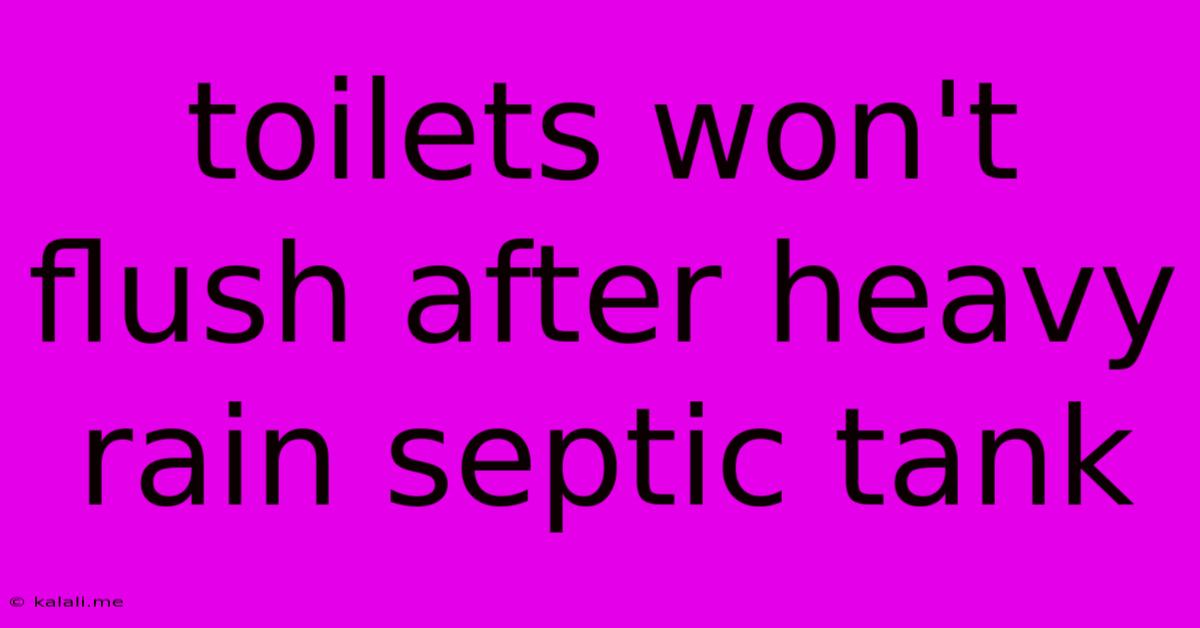Toilets Won't Flush After Heavy Rain Septic Tank
Kalali
Jun 08, 2025 · 3 min read

Table of Contents
Toilets Won't Flush After Heavy Rain: Septic Tank Issues Explained
Heavy rain can wreak havoc on your plumbing system, and a septic tank is no exception. If your toilets won't flush after a downpour, the culprit might be your septic system struggling to cope with the increased water volume. This article explores the common reasons why this happens and offers solutions to get your toilets flushing again.
Understanding the Problem: Septic Tank and Heavy Rain
Septic systems rely on a natural process of decomposition. When excessive rainwater enters the system, it overwhelms the bacteria responsible for breaking down waste. This leads to several potential problems, all resulting in sluggish or non-functioning toilets. The most common issues include:
- High Water Table: Heavy rainfall saturates the ground, raising the water table. This can cause the drain field, where wastewater is treated, to become waterlogged. The wastewater has nowhere to go, creating a back-up into the house.
- System Overload: The sudden influx of water from the rain overwhelms the septic tank's capacity. This forces untreated wastewater to back up into the plumbing system, impacting your toilets and other fixtures.
- Clogged Drain Field: Years of accumulated solids or a poorly designed drain field can become easily overwhelmed by excess water, leading to blockage and backflow.
- Cracked or Damaged Pipes: Heavy rains can expose weaknesses in your septic system's pipes, leading to leaks and blockages that further exacerbate the problem.
Troubleshooting and Solutions
Before calling a professional, try these troubleshooting steps:
1. Check for Obvious Blockages:
- Toilet: Ensure nothing is blocking the toilet bowl itself.
- Bathroom Sink and Shower: Check these for slow drainage, as this could indicate a more widespread issue.
2. Inspect the Septic Tank:
- Locate the Lid: This is usually marked with a noticeable cover. Caution: Never open a septic tank without proper training and safety equipment. The gases inside are dangerous.
- Observe the Lid: Look for signs of bulging or excessive pressure, indicating a full tank. A slightly sunken lid might also indicate issues.
3. Monitor the Drain Field:
- Check for Waterlogging: Look for saturated or unusually wet ground around the drain field. Standing water is a clear sign of a problem.
4. Avoid Using Water-Intensive Appliances:
- Reduce Water Usage: Until the issue is resolved, minimize usage of appliances that add to the water load, such as washing machines and dishwashers.
When to Call a Septic Tank Professional
If the problem persists after these steps, or if you notice any signs of sewage backing up, it's crucial to call a professional septic tank service. They can:
- Pump the Septic Tank: Removing accumulated sludge and wastewater can significantly alleviate the pressure.
- Inspect the Drain Field: They can identify and repair any cracks, clogs, or design flaws.
- Assess the System's Health: A professional evaluation can pinpoint the underlying cause of the problem, preventing future occurrences.
- Recommend System Upgrades: They might suggest improvements, such as adding a pump or replacing outdated components.
Preventative Measures
To prevent future issues after heavy rainfall:
- Regular Septic Tank Pumping: Schedule regular maintenance to remove accumulated solids and prevent overflow.
- Proper Landscaping: Avoid planting trees or shrubs with extensive root systems near the drain field, as these can damage the pipes.
- Water Conservation: Practice water conservation to reduce stress on your septic system.
Addressing toilet flushing issues after heavy rain requires a systematic approach. While some basic troubleshooting can be done at home, professional assistance is often needed for a thorough assessment and effective solution. Remember, a well-maintained septic system is crucial for a functioning home, and proactive maintenance is key to avoiding costly repairs.
Latest Posts
Latest Posts
-
What Has One Eye But Cant See
Jun 09, 2025
-
How To Turn Off An Ipod
Jun 09, 2025
-
How To Get Rid Of Bathroom Sink Smell
Jun 09, 2025
-
How Long Would It Take To Walk Across America
Jun 09, 2025
-
Not All Code Paths Return A Value
Jun 09, 2025
Related Post
Thank you for visiting our website which covers about Toilets Won't Flush After Heavy Rain Septic Tank . We hope the information provided has been useful to you. Feel free to contact us if you have any questions or need further assistance. See you next time and don't miss to bookmark.